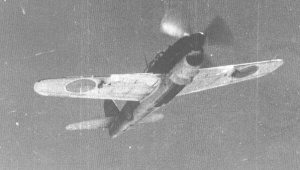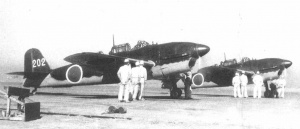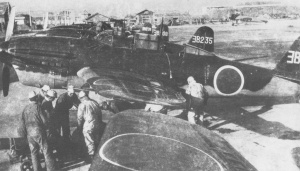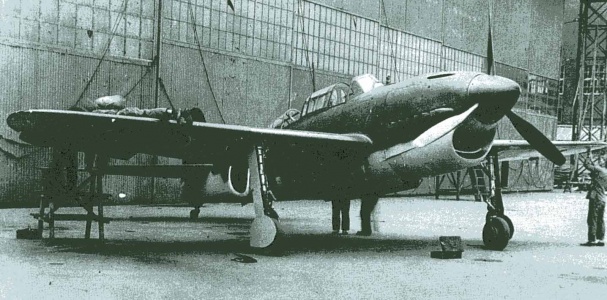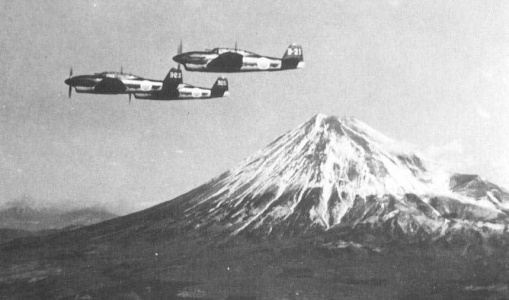D4Y (Family)
Contents
Description
The Yokosuka D4Y was a two-seat carrier-based dive bomber used by the Imperial Japanese Navy in World War II.
Nicknames being:
- ▅ - Suisei (彗星, Comet)
- ▃ - Judy
Vehicles
Rank II
History
Development
- Yokosuka D4Y Suisei
13-Shi Carrier-based Dive Bomber
Development of the D4Y Suisei started as the 13-Shi Carrier Dive-Bomber in the Yokosuka Naval Air Technical Arsenal after the Imperial Japanese Navy Aviation Bureau issued an order for a dive-bomber with two main requirements: have a larger range than enemy carriers and their planes, and the ability to shake off interception fighters chasing them. The official stated requirements were as follows:
Speed ≥ 280 kn Cruising speed ≥ 230 kn Dive-bomb range ≥ 800 nmi (~1,482 km). Bombing range ≥ 1200 nmi (~2,222 km). Ordnance = 1 x 500 kg (Type 2 No.50 Bomb)
While the 11-Shi Carrier Dive-Bomber (later D3A1) was still in development, the requirements for the 13-Shi were far higher than its still-in-development predecessor. Hence engineers looked at the higher performance of the DXHe1, the Navy designation for the imported He 118 they acquired for tech evaluation.
The design of the 13-Shi included electrical-driven hydraulics ranging from landing gear, flaps, and bomb-bay doors, making it the first Japanese carrier-based plane to have a bomb bay. The fuselage was narrowed down to just the diameter of the engine and referenced to the DXHe1; the radiator and air cooler were flush with the bomb bay to minimize air resistance and have a smooth underside. To balance the aerodynamic aspect and bomb bay, the primary wing size was kept to a minimum to reduce induced drag and achieve higher speeds. To eliminate the need of folding wings, the wingspan was reduced to 11 m, matching Japanese carrier elevators. Additionally, a semi-integral fuel tank was implemented to carry a large amount of fuel required for long cruising distances.
But with all these measures in pursuit of high top speeds, the wings were too small to operate with the short take-offs and landings required for carrier planes, resulting in various designs, such as a semi-Fowler-type flap that covered 60% of the wing span, the ailerons and air brakes to be used as take-off/landing flaps. Even with that design employed, it would only be usable loaded on large, high-speed carriers of the Shōkaku class or better.
On November 1, 1940, the first 13-Shi prototype was built and was equipped with the AE2A Atsuta 11 engine (licensed DB 600G). But due to engine malfunctions, it was discarded and swapped out for the AE1A Atsuta 21 (licensed DB 601), which pushed the 13-Shi with a reconnaissance loadout to 552 km/h at 4,750 m, which was the highest speed of any naval aircraft for its time. On top of that, the operational range was recorded at 3,780 km. There were a total of 5 prototypes built eventually.
With the engine being a liquid-cooled inverted V12 engine, it did outperform most of its Japanese counterparts, but a lack of industrial power, rare resources for engine parts, and overall maintenance complexity caused reliability issues and strained engine production in numbers.
(D4Y-C) Type 2 Carrier-based Reconnaissance Plane
On October 21, 1941, the 1st Carrier-Division, which was preparing the attack on Pearl Harbour before the outbreak of the Pacific war, sent a request to the Aviation Bureau to increase the number of A6M2s and 13-Shi's to be produced for combat on-top of attaching a new reconnaissance plane.
The Navy did agree that it needed a new, high-speed recon plane to replace the Type 97 carrier-based attack bomber (B5N) used in recon-role and Type 0 Reconnaissance Seaplane (E13A). With the vision of modifying the 13-Shi in a reconnaissance role, an order of 40 recon variants was made in November of 1941. Prototype airframes No.2, 3 & 4 were already remodelled into reconnaissance planes with cameras equipped in the bomb bay. It took more than half a month to arrive to forward units and didn't end up being used in the opening wave of the Pacific War.
In May 1942, the already converted airframes No.2 & 3 would be deployed to the Soryū as part of the 2nd Air Squad., 1st Carrier Div. During the battle of Midway, it was one of the planes that spotted the US Carrier Fleet, but due to a radio malfunction, it had to report back directly to the sister-ship Hiryū, as Soryū, together with the other plane, had already been struck on its return. Later in the battle, Hiryū was sunk as well, sinking with the last frontline deployed recon prototype.
On August 15, 1942, Airframe No.5 crashed in a test flight, and engineers concluded that the airframe should be repaired and strengthened as it would be insufficient to be used as a dive-bomber. The strengthening of the airframe didn't interfere with the flight performance of the plane.
After frontline evaluation and last recon modifications, the reconnaissance variant would formally be adopted as the Type 2 carrier-based reconnaissance plane (D4Y1-C) and began deployment at the end of 1942. It would operate relatively well and was well received by its crew.
(D4Y) Suisei
From June 1943, the 13-shi was finally ready after getting an improved airframe and prepared for mass production and would be officially adopted (under new naming regulations) as the Suisei 11 (D4Y1) and would see its debut combat at the Solomon islands in the latter half of 1943.
In May 1943, the first Suisei 12 (D4Y2) with the improved Atsuta 32, which offered 1400 hp over the 1200 hp Atsuta 21 and was easier to maintain, was ready. But with the lack of rare metals such as nickel, lack of skilled workers, and shortage of tools, the production of the Atsuta 32 delayed the deployment of Suisei 12s, with the result of stacking numbers of "noseless aircraft" (lacking engine) lining up outside the factory. As a breakthrough countermeasure for lacking engine production, in December 1943, roughly half a year after the first Suisei 12, the Suisei 33 (D4Y3) arrived, equipped with the Mitsubishi MK8P Kinsei 62 air-cooled radial engine, which was far more reliable and had a relatively large supply, solving the logistical nightmares of the licensed DB 601. This breakthrough simultaneously solved the same problems of the Army which dealt with the DB 601 (as the Kawasaki Ha-40) in its Ki-61s with the exchange for the Mitsubishi Ha-112, which would evolve the plane into the Ki-100.
Media
- Images
- Videos
| Yokosuka Naval Air Technical Arsenal (海軍航空技術廠) | |
|---|---|
| Bombers | D4Y1 · D4Y2 · D4Y3 Ko |
| P1Y1 mod. 11 | |
| Jet fighters | R2Y2 Kai V1 · R2Y2 Kai V2 · R2Y2 Kai V3 |
| Captured | ␗P1Y1 mod. 11 |
| While the arsenal was simply known as the Naval Air Technical Arsenal and usually referred to as Kūgi-shō (Kaigun Kōkū Gijutsu-shō). | |
| The name Yokosuka prevailed however, even though it referred to the Arsenal's location. | |
| See also | Yokosuka Naval Arsenal (Shipyard) |
| Japan bombers | |
|---|---|
| Navy | |
| Carrier-based attack bomber | |
| B5N | B5N2 |
| B6N | B6N1 · B6N2 · B6N2a |
| B7A | B7A2 · B7A2 (Homare 23) |
| Carrier-based dive bomber | |
| D3A | D3A1 |
| D4Y | D4Y1 · D4Y2 · D4Y3 Ko |
| Shipboard Observation seaplane | |
| F1M | F1M2 |
| Land-based Attack bomber | |
| G4M | G4M1 |
| G5N | G5N1 |
| G8N | G8N1 |
| Flying boat | |
| H6K | H6K4 |
| H8K | H8K2 · H8K3 |
| Land-based Bomber | |
| P1Y | P1Y1 |
| Army | |
| Light | Ki-32 |
| Ki-48-II otsu | |
| Heavy | Ki-21-Ia · Ki-21-I hei |
| Ki-49-I · Ki-49-IIa · Ki-49-IIb · Ki-49-IIb/L | |
| Ki-67-I Ko · Ki-67-I otsu | |
| Other countries | ▅B-17E |


